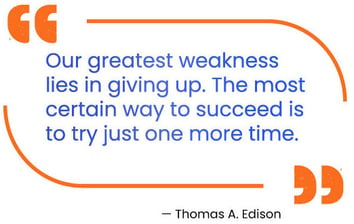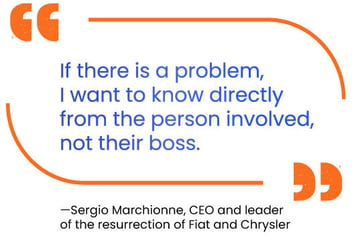
Historically, the posture of established businesses has been defensive, carving out markets and defending them. The management mindset was to maintain the status quo by putting up barriers to entry.
When rapid technology progress removed the barriers, innovators leaped ahead of industry leaders in months or years instead of decades.
Companies that caught the waves of change succeeded. Those that didn’t became history. Think of companies like Kodak, Honeywell, Atari, and WordPerfect.
In contrast, these innovators created different stories:
- Amazon started as an online bookseller. Through innovation, it became the world’s leading retailer.
- Microsoft was a stodgy technology giant that created an innovation culture. It continues to innovate on many fronts.
- Apple caught three technology waves in one decade: digital music, smartphones, and tablets, and rewarded its investors with a 2,378% return on investment.
- If you invested $1000 in Tesla in November 2011, it was worth $204,000 ten years later. (It’s still growing.)
These examples show the reality of a business world in a state of disruption, where every company is a technology company.
What is Innovation?
At its most basic, innovation is doing things in new ways. It’s action generated by creative ideas.
We often think of creativity as accidental and unpredictable, but we can, and often do, purposely generate ideas. It isn’t a skill but a way of thinking you can refine and repeat.
In psychology, we define creativity in three ways:
- Combination Creativity happens when you connect ideas already in your brain. Think about the apples that Isaac Newton observed falling from trees. It was a trigger event that brought together ideas Newton had been pondering about why things fall to earth.
- Exploratory Creativity results from using ideas you already have, then thinking beyond what you know.
- Transformational Creativity happens when you examine a limiting rule and ask what would happen if the rule didn’t exist. It’s assuming “the ideas in your head are actually wrong.”1
The Fourth Dimension
But there is another dimension to consider.
Think about what happens in a brainstorming session. You create ideas beyond the thinking of a single individual—more ideas to explore, more rules to break. Those ideas have the power to transform your organization.
However, creation isn’t innovation until you put ideas into action to create value.
What Does an Innovation Culture Look Like?
After over two decades of accelerating waves of change, the characteristics of innovative organizations have become well known. Our business schools teach the principles. Though each global consulting firm has its unique approach, the underlying fundamentals don’t differ much.
So why doesn’t every attempt at innovation succeed?
And why is it so hard to do?
The Paradoxes of Innovative Culture
Gary P. Pisano of Harvard Business School explains that the principles of innovative culture are paradoxical. Each positive has a negative, and companies that focus only on the positive don’t have the discipline to succeed. They enjoy the fun side but “don't do the things that are difficult.” 
Source: “Innovation Isn’t All Fun and Games — Creativity Needs Discipline.”
— Gary P. Pisano, Harvard Business Review
Let’s dig into the positives and see why you should embrace the negatives.
Tolerance for Failure

Experimentation is the lifeblood of innovation. Thomas A. Edison received 1,093 patents over his lifetime. But he also had thousands of failures, and he welcomed them.
Gary P. Pisano cites three more recent failures, which all but the youngest of us will remember: He asks, “Remember Apple’s MobileMe, Google Glass, and the Amazon Fire Phone?”
All three companies used their failures to create future success. When we punish failure, we kill innovation. A failure must be an invitation to try again, and we should celebrate failures that lead to learning.
But Intolerance for Incompetence
However, tolerance for failure doesn’t mean a lack of accountability. Your company will fail if it doesn’t hold people accountable for results.
Sandy Ogg’s Talent to Value approach tells us that if you want your company to succeed, you must have talented people who create value in the right roles.
Sometimes jobs change faster than people can, and you must make a change. The compassionate and pragmatic thing to do is move people who don’t succeed to another role.
At Google, the company moves people who don’t succeed into different roles where they can.
As Lars Dalgaard was growing SuccessFactors from a $110,000 investment to a $4+ billion buyout in less than eight years, he often helped people who didn’t succeed find more suitable roles at other companies.
Willingness to Experiment
Being comfortable with uncertainty and ambiguity are requirements for an experimental mindset. You can’t merely think yourself to success; you must try new things, which means accepting a measure of risk.
But Highly Disciplined
Disciplined organizations established clear criteria and methods for experimentation. When an experiment shows that an idea was wrong, they move on quickly. They have no tolerance for “pet projects.”
Psychologically Safe
Creative ideas abound in an organization where people feel safe speaking openly about problems without fear. An organization that doesn’t welcome the truth will never be innovative.
But Brutally Honest
Psychologically safety requires two-way candidness. Criticism may be sharp-edged or very polite, but a culture that welcomes honest feedback regardless of position in the company fosters innovation when others fail.
At SuccessFactors, Lars Dalgaard’s views on candid feedback were a part of the onboarding process. His philosophy (and company policy) was that the kindest feedback is brutal honesty.
Collaborative
In a collaborative culture, people seek help from colleagues naturally, regardless of position or job description. Ideas flow freely, and people form teams naturally through a shared sense of responsibility.
But Individually Accountable
Collaboration isn’t consensus. Building consensus to make decisions slows down the process and often results in grudging agreement. Not only that, but it also leads to blame for failures.
Rapid decision-making requires that one person have the responsibility and authority to make a decision and be accountable for the result.
If you make a decision, you own it, but that accountability will drive you to seek collaboration with others more knowledgeable than you to help you make better decisions.
Flat Organization
Flat organizations make decisions and act faster than their hierarchical counterparts. The absence of multiple levels of approval creates a more dynamic, responsive organization.
With Strong Leadership

Flat organizations without strong leadership often devolve into chaos without clear direction. Having the right culture will make the right things happen, but without a structure to manage priorities, conflict will tear it apart.
When companies have a flat structure and strong leadership, they outperform their competitors because people have the autonomy to pursue innovative ideas, and top leaders are closer to the action.
Innovation by Design
In 2013, Salesforce had difficulty staying agile during a period of fast growth. They didn’t see how to organize themselves to manage both established business units and new investments.
They worked with Geoffrey Moore, author of Crossing the Chasm, to scale new products while sustaining the existing business lines. The result was an astounding success for Salesforce and a new book, Zone to Win, a prescription for innovating without disrupting your entire business.
We have seen many ways to create islands of innovation in organizations with independent groups of innovators. In our experience, the most common reason they fail is the conflict with the core business for resources. Zone to Win aims to show you how to manage resource allocation and priorities to remove those conflicts.
Working with Microsoft and Salesforce, Moore developed the idea of zones in organizations that remain connected to each other but not in lockstep with them.
In the Foreword to the book, Marc Benioff, CEO of Salesforce, tells how Salesforce is “not just surviving but succeeding in today’s disruptive, connected, fast-paced business world.”5
We recommend reading the book, but here’s an overview of how it works.
Define Investment Horizons
The first step in the process is defining when you expect the return on your investment:
- Horizon 1: In the coming fiscal year, coming together with the operating plan. This is sustaining action to reap returns on prior investment.
- Horizon 2: Two to three years, with a significant negative cash flow, diluting the operating plan. This is where you turn one of the Horizon 3 options into an asset.
- Horizon 3: In three to five years of research and development, separately funded, so it doesn’t dilute the operating plan. This zone creates a “portfolio of strategic options” that you intend to turn into Horizon 1 assets.
This model separates the priorities, so you can simultaneously operate the core business while becoming a disruptor—without the usual conflict. All your foes are outside the company.
Separate Disruptive Innovation and Sustaining Innovation
The purpose of the separation is to allow the organization to “fight on multiple fronts” without competition for resources.
Disruptive innovation focuses on net new business and sustaining innovation on improvements to and extensions of existing business.
Separate Revenue Performance from Enabling Investments
Revenue performance is about delivering results now. Enabling investments promise future returns.
The Four Zones
Moore develops four management zones, separate but in cooperation. Each one requires a unique leadership style. 
The Performance Zone
This zone is where your proven business model creates revenue. The focus is on sustaining performance. It’s where the profits come from.
When you innovate to add a new line of business, the performance zone must keep its revenue commitments and drive innovation. That burden creates resource allocation, talent, and marketing issues you must resolve.
When a competitor challenges your established business lines, your disruptive ideas go on hold while you use those resources to fight off the challenger.
Over-committing to the performance zone instead of preparing for the future will ensure failure. It’s only one of four dimensions.
The Productivity Zone
Moore describes the productivity zone as the “enabling investments in shared services,” the cost centers that support Zone 1: marketing, engineering, human resources, customer service, finance, legal, and administrative services—functions without accountability for revenue.
Its responsibilities are compliance, efficiency, and effectiveness, requiring a balance among them to support all the other zones.
This zone is tough to manage during a disruption. The challenge requires more efficiency and effectiveness, but the organization chafes at compliance.
The Incubation Zone
This zone is where you create the ideas. It’s an investment in the future, where you can only expect a contribution to revenue in the out years.
You must keep performance and incubation separated. One is the producer of current revenue. The other produces future value.
The challenge in the incubation zone is when all the focus is on the performance zone to fight off disruptors. What you intended as a future disruptor becomes a tool for dealing with the current crisis.
The Transformation Zone
The transformation zone is where you prepare the deployment of incubated innovations to become a disruptor.
Its purpose is to catch each wave of technology to become a leader in disruption. It’s where you take the initiative by determining new priorities and shifting investment to the next wave. It’s the new direction that becomes the performance zone of the future.
Bringing it All Together
In this article, we’ve shown you a high-level view of how innovation works, how to create an innovation culture, and how to organize a framework for innovation.
We hope we have inspired you to build an organization that fosters innovation to seize future opportunities.
References:
Boden, Margaret A. “Neuroscience of Creativity - University Press Scholarship.” University Press Scholarship Online. The MIT Press, September 20, 2013. https://www.universitypressscholarship.com/view/10.7551/mitpress/9780262019583.001.0001/upso-9780262019583-chapter-1.
Marone, Mark. “Accenture Technology Innovation Report 2021.” Accenture. Accessed May 8, 2022. https://www.accenture.com/us-en/insights/technology/technology-innovation-report.
Pisano, Gary P. “Innovation Isn't All Fun and Games - Creativity Needs Discipline.” Harvard Business Review, June 6, 2020. https://hbr.org/2019/01/the-hard-truth-about-innovative-cultures.
Moore, Geoffrey A. “Zone to Win: Organizing to Compete in an Age of Disruption by Geoffrey A. Moore.” Diversion Books, November 3, 2015. https://www.goodreads.com/book/show/27418306-zone-to-win.
Ogg, Sandy. “Connecting Talent to Value - Part 1.” Sandy Ogg. Sandy Ogg, March 18, 2019.
Editors, Forbes Technology Council. “Council Post: Why Every Company Is a Technology Company.” Forbes. Forbes Magazine, January 23, 2017. https://www.forbes.com/sites/forbestechcouncil/2017/01/23/why-every-company-is-a-technology-company/.
PhenomᵉCloud is a full-service technology company dedicated to helping clients solve business problems, improve the capability of their people, and achieve better results.


Leave a Comment